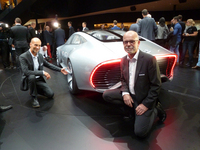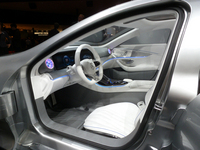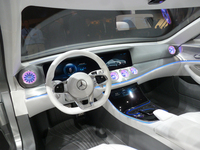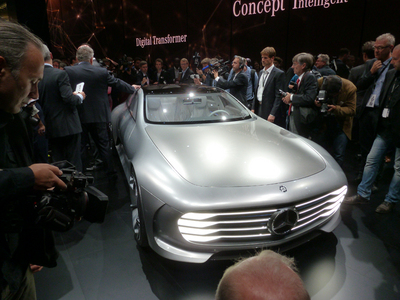2015 Frankfurt Motor Show - Mercedes-Benz: Mobility Connects at IAA and Concept IAA Connects To The Future
By Henny Hemmes
Senior European Editor
 Mercedes-Benz Concept IAA |
FRANKFURT - September 15, 2015. This morning the IAA opened its doors to the media and later this week the public will swarm over the huge exhibition site with no less than eleven halls. ‘Mobility connects’ is this year's slogan for the show. According to Matthias Wissmann, president of the VDA (German association of the automotive industry and organizers of the IAA), the 66th edition of the IAA “shows the digital world of mobility.”
We may be cleverly connected by smart phone with cars and be prepared for autonomous driving, but we remain human beings. A fact that once again became clear, when the inaugural presentation of the day took a scary turn. Just shortly after starting the news conference, BMW chief Harald Krüger fainted on stage, shocking the guests. He was clearly dizzy and later, a BMW spokes person said that Mr. Krüger had not felt well that morning after heavy travel around the world during the preceeding week. The press conference was cancelled and Mr. Krüger was taken care of by a doctor.
BMW announced later that that mr. Krüger was was recovering well and was going to take a couple of days rest. Like Daimler and the Volkswagen Group, BMW AG occupies a major hall in the exhibition.
Mercedes-Benz Shows More Of The Future
 Mercedes-Benz Concept IAA |
Of course, the abbreviation is that of Internationale Auto Ausstelling (exhibition), but Daimler’s CEO Dieter Zetsche himself had come up with a completely different meaning: Intelligent Aerodynamic Automobile. It speaks for itself that the car manufacturer had to ask the VDA permission for use.
 Dr. Teddy Woll on left and Martin Konerman on right |
After the presentation, I walked up to Dr. Teddy Woll, whom I interviewed two years ago about the aerodynamics of the new S-Class. He is the head of aerodynamics/windtunnel department and was accompanied by Martin Konermann, also an aerodynamics expert and the chief engineer of the Concept IAA. Both were happy to tell more about the development process that started seven months ago.
“This is the first car that has been completely ‘computer-developed’, Dr. Woll said. Everything, including the final measurements, before it went into the (brand new) wind tunnel in Sindelfingen. Mr. Konemann said that the team had spent one million CPU hours: “Many processors worked parallel. We had 300 variants.”
 Mercedes-Benz Concept IAA |
The team started with a clay model that was digitally optimized. “Then it was built up as a full size clay model and adjusted and it went ‘back into the computer’ and we developed the active elements.” He means the wheels that ‘pop out’ as saucers, as soon as the car reaches 80 km/h, 50 mph and the rear end that is automatically extended by over a foot. “That is the moment, the design mode transforms into the aero mode,” Dr. Woll said.
Both were very pleased by the way they along with two aerodynamic engineers worked together with the team of a handful designers lead by design chief Dr. Gorden Wagoner. In aerodynamic mode the car has a cD-value of 0.19, in ‘beauty’ mode it is 0.25. Mr. Konermann explains: “The difference of 6 drag counts is reached as follows: Ten drag counts by the wheels, of which the hubs are pushed outside by centrifugal forces and form flat saucers. You do not see that when you drive fast.
 Mercedes-Benz Concept IAA |
Dr. Woll advised me to take a very good look at the dashboard and the interior in general. “This design is the forebode of the next E-Class,” he says, not meaning the 2016 model, but the one that Mercedes has recently has started developing and that will be due to be unveiled around 2020.



